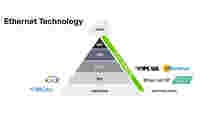SPE as a Key Technology
Single Pair Ethernet: Paving the Way for Open Automation
Barrier-Free Data Transfer with Single Pair Ethernet
Single Pair Ethernet (SPE) is an important milestone in automation: It simplifies industrial communication and enables barrier-free data transfer – from the field level to the cloud.
In contrast to conventional ETHERNET, SPE requires only a single pair of conductors and is standardized by the IEEE. This new technology has the potential to reduce the number of network transitions, enabling seamless IP communication at best.

